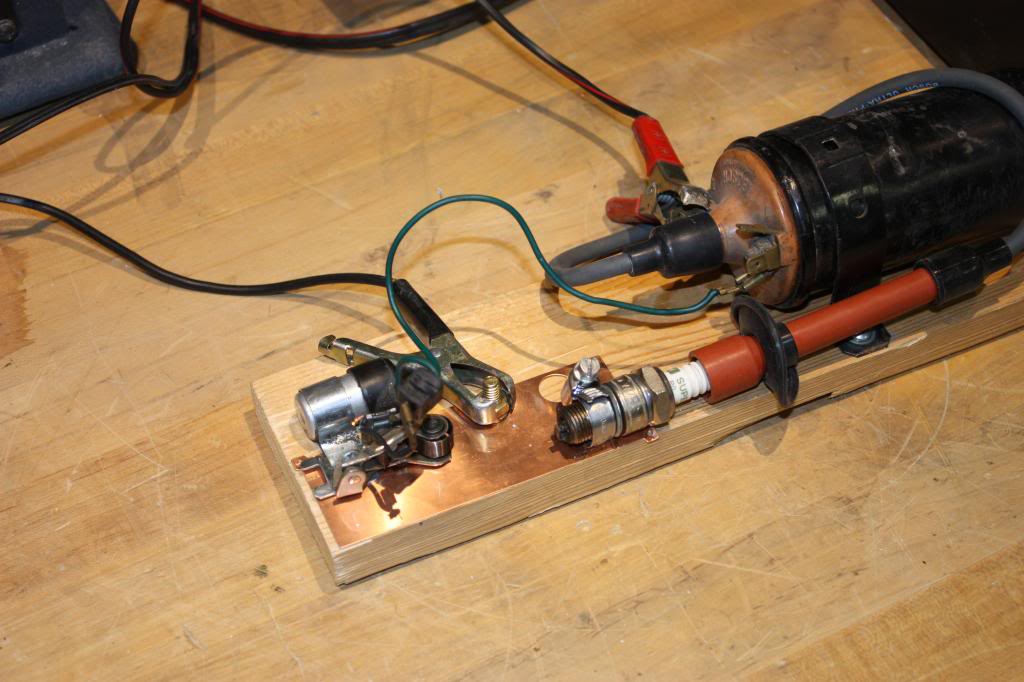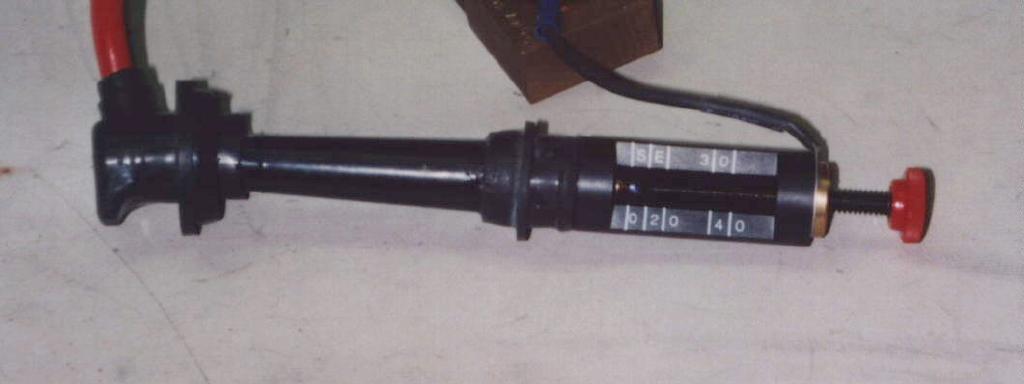thanks.....
Full Version: is there a simple way to test a ignition coil?
got a box full of them. want to use a good one. not interested in buying a new one "if" I have 5 good ones on my shelf.
thanks.....
thanks.....
I assume you mean ignition coils.
You could measure the resistance from + to -, and + to distributor output. They should all be the same for each measurement. Get a known good coil as the standard.
What you won't be able to measure if any are heat sensitive.
You could swap them in and out of a engine to check. The coil doesn't have to be mounted to do this; just moving wires.
You could measure the resistance from + to -, and + to distributor output. They should all be the same for each measurement. Get a known good coil as the standard.
What you won't be able to measure if any are heat sensitive.
You could swap them in and out of a engine to check. The coil doesn't have to be mounted to do this; just moving wires.
I have a setup that is more than you are probably talking about.
I have a spark plug with an adjustable spark gap, a set of points, battery charger that I was using to experiment with Ignition pulse detection.
The adjustable gap plug was a few bucks at harbor freight
This pic shows it with a standard spark plug:

And a video of a fouled plug.
http://vid366.photobucket.com/albums/oo101...zpslne8tn0r.mp4
This is the gap tester:

So to test coils, I would put each in the test rig, and open the plug gap until you get no spark.
The plug gap is marked in 1000 volt measurements so you could tell if one coil was putting out a weaker spark than a"known good" coil.
The resistance check is better than nothing but you could have hundreds of windings shorted out and not be able to tell with the DC resistance check since the R is so low already (3-5 Ohms).
I have a spark plug with an adjustable spark gap, a set of points, battery charger that I was using to experiment with Ignition pulse detection.
The adjustable gap plug was a few bucks at harbor freight
This pic shows it with a standard spark plug:

And a video of a fouled plug.
http://vid366.photobucket.com/albums/oo101...zpslne8tn0r.mp4
This is the gap tester:

So to test coils, I would put each in the test rig, and open the plug gap until you get no spark.
The plug gap is marked in 1000 volt measurements so you could tell if one coil was putting out a weaker spark than a"known good" coil.
The resistance check is better than nothing but you could have hundreds of windings shorted out and not be able to tell with the DC resistance check since the R is so low already (3-5 Ohms).
@spoke, yes ignition coil...edited the title. thanks.
@stugray, holy crap, you people never cease to amaze me.
I'll see what spoke's test tells me...I'm sure the one in question is good, just curious if there was a basic test.
@stugray, holy crap, you people never cease to amaze me.
I'll see what spoke's test tells me...I'm sure the one in question is good, just curious if there was a basic test.
There is an old thread on this. If no one finds it I'll get it tonight. On my phone now.
As example (can't remember the exact). Center to + needs to read no less than xx ohms volts something and then. + to - needs to be xx something. You can google testing Bosch coils too and there are VW threads too. Did this a year ago.
Will update this whn I find something. Search is a good friend.
Try this
http://www.thesamba.com/vw/forum/viewtopic.php?t=410728
As example (can't remember the exact). Center to + needs to read no less than xx ohms volts something and then. + to - needs to be xx something. You can google testing Bosch coils too and there are VW threads too. Did this a year ago.
Will update this whn I find something. Search is a good friend.
Try this
http://www.thesamba.com/vw/forum/viewtopic.php?t=410728
Throw it in a pond and if it floats its no good.
I believe a coil can test good with a multimeter and still be bad. But if it tests bad, it is. I recently had an issue with the coil on my old Cub Cadet and it tested good but still would not run right, or it would run a little while then quit. So I took my 914 coil and mounted it on there and it worked.
So I just bought a new coil to put on the car.
So I just bought a new coil to put on the car.
I believe the DC resistance of the + to - should be in the range of about 3 ohms, the + to center should be 8-12K ohms.
Tom
Tom
I was just going thru this recently myself and ran across this on pelican.
Measuring from + to neg is .75 ohms to 0.81, and from the center pole to + should be 10,000 ohms to 11,000 ohms.
I guess thats one plave to start.
Measuring from + to neg is .75 ohms to 0.81, and from the center pole to + should be 10,000 ohms to 11,000 ohms.
I guess thats one plave to start.
Just thought I should throw this out there.
A simple DC resistance test will only test the primary and secondary windings under not running conditions. Coils will and do break down under heat and electrical load. Many folks get really discouraged when testing ignition systems on cars that won't start or run right and when doing the spark plug outside the engine test get a spark. Well there are sparks and there are SPARKS. A strong blue spark is preferred.
I remember back in about 1970 taking a gas engine course and during the ignition part the instructor showed us an engine that had what seemed to be a good spark. Would not start! The class went thru the entire electrical troubleshooting procedure to try to get the engine to fire. Finally after trading out the coil for a new one, it fired and ran fine. The old coil was putting out a spark that was slightly weak. I wish I could remember why the weaker coil produced what to us looked like a good spark but would not fire under compression. I am sure he explained it, I just can't remember.
A few years later while playing with RD-350's, I had Don Vesco's shop port and polish the cylinders/pistons, and machine the head for increased compression. The mechanic that performed the work also told me I would have ignition issues if I did not improve the ignition system. When I asked what to do, he said go to K-mart and buy a $6.00 K-Mart coil and install it and widen the plug gap by 0.010 inches. Well I did what he said and it fired just fine. Boy that bike was fast for it's time!!!
Maybe Jake or one of the engine builders could tell us more on why coils break down under higher compression. I have heard of lots of guys that had a great running car only to rebuild it with higher compression pistons and then have issues with the stock ignition system.
Tom
A simple DC resistance test will only test the primary and secondary windings under not running conditions. Coils will and do break down under heat and electrical load. Many folks get really discouraged when testing ignition systems on cars that won't start or run right and when doing the spark plug outside the engine test get a spark. Well there are sparks and there are SPARKS. A strong blue spark is preferred.
I remember back in about 1970 taking a gas engine course and during the ignition part the instructor showed us an engine that had what seemed to be a good spark. Would not start! The class went thru the entire electrical troubleshooting procedure to try to get the engine to fire. Finally after trading out the coil for a new one, it fired and ran fine. The old coil was putting out a spark that was slightly weak. I wish I could remember why the weaker coil produced what to us looked like a good spark but would not fire under compression. I am sure he explained it, I just can't remember.
A few years later while playing with RD-350's, I had Don Vesco's shop port and polish the cylinders/pistons, and machine the head for increased compression. The mechanic that performed the work also told me I would have ignition issues if I did not improve the ignition system. When I asked what to do, he said go to K-mart and buy a $6.00 K-Mart coil and install it and widen the plug gap by 0.010 inches. Well I did what he said and it fired just fine. Boy that bike was fast for it's time!!!
Maybe Jake or one of the engine builders could tell us more on why coils break down under higher compression. I have heard of lots of guys that had a great running car only to rebuild it with higher compression pistons and then have issues with the stock ignition system.
Tom
The Haynes manual tests are pretty simple.
Maybe Jake or one of the engine builders could tell us more on why coils break down under higher compression. I have heard of lots of guys that had a great running car only to rebuild it with higher compression pistons and then have issues with the stock ignition system.
Tom
Here is why:
Voltage breakdown in air (or any gas) is when a voltage potential can arc across a gap.
The bigger the gap, or the higher the pressure, the more voltage is required to jump the gap.
(disclaimer - numbers are approximate for sake of discussion)
The voltage for breakdown in air with 0.7mm gap at 1 ATM pressure (14.7 PSI) is ~3400 Volts
An engine with a static CR of 8:1 will compress the air to 8 ATM (~118 PSI) which is ~19,000 Volts
An engine with a static CR of 10:1 will compress the air to 10 ATM (~147 PSI) which is ~23,000 Volts
So to get a spark to even start in the combustion chamber with the stock compression ratio, you need greater than 20,000 volts.
As you increase the CR, you increase the voltage required to start the spark.
So if you do not bump up the voltage that the ignition system can deliver, then to get any spark at all with the higher CR, you would need to reduce plug gap.
Smaller plug gaps mean less energy delivered per spark, and performance drops off.
It gets way more complicated after spark ignition, but you get the point.
Regardless of CR, you can increase gap if you have a higher ignition output voltage.
This is why the MSD is so popular.
It allows a bigger gap.
It's a duck
This is a "lo-fi" version of our main content. To view the full version with more information, formatting and images, please click here.
